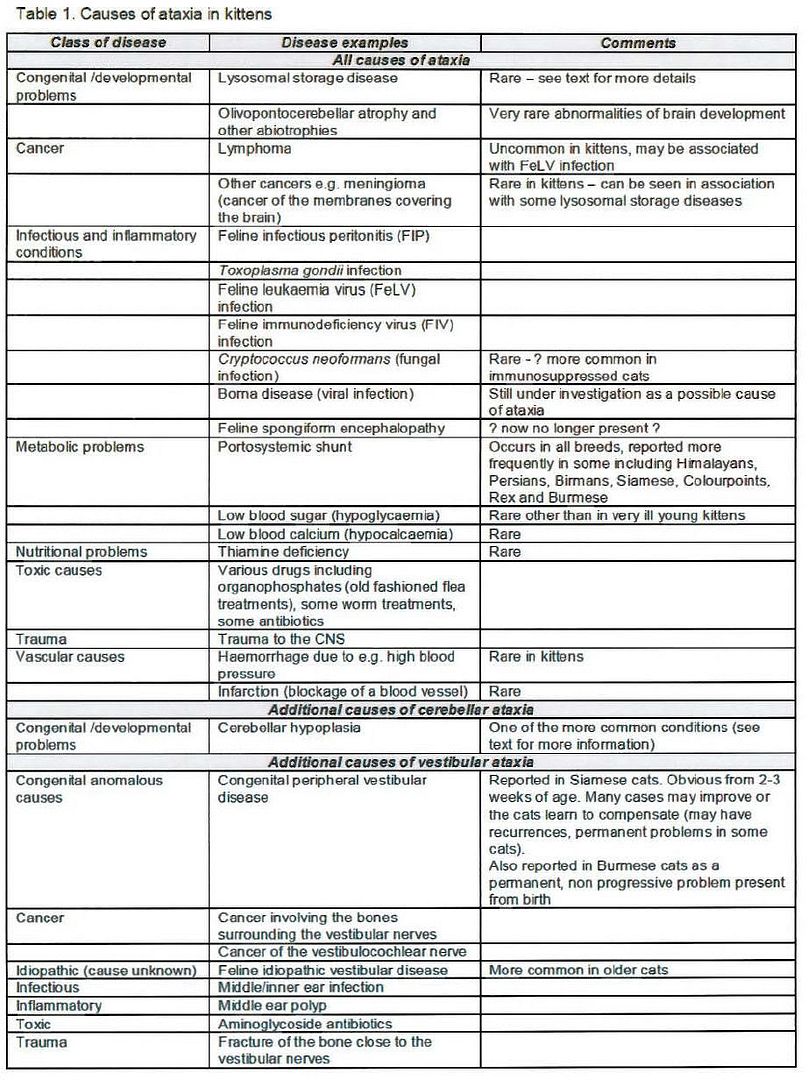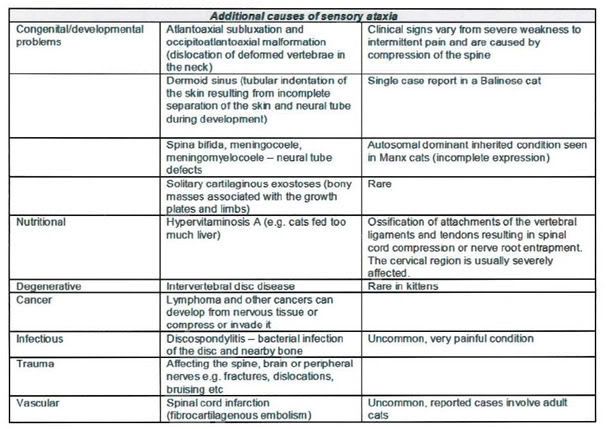A 1500 word article discussing the causes and diagnosis of ataxia (a wobbly gait) in young cats.
Wobbly Kittens
Sarah M. A. Caney BVSc PhD DSAM (Feline) MRCVS
Introduction
There are many causes of gait abnormalities in kittens which include:
• Problems with the nervous system
• Problems with other body systems which have an effect on how the brain or nerves work
• Weakness -many causes of this including anaemia, lack of food or fluids etc:
• Orthopaedic problems (problems with the bones and joints)
• Muscle problems
Some of these problems are congenital ie, present from birth whist other problems develop later on.
Some of the diseases are inherited whilst others occur for other reasons including infectious causes.
Ataxia is the medical term for a wobbly, drunken or unsteady gait. Ataxia is caused by problems affecting the sense of motion or position of the body and limbs. The term ataxia is usually reserved for describing cats with neurological problems, but it can sometimes be difficult to distinguish ataxia from non-neurological problems such as weakness which can also cause a wobbly gait. There are a large number of different causes of ataxia in kittens, this lecture will focus on some of the more common causes which can be diagnosed in practice. Causes of ataxia can be split into three main categories:
1. Cerebellar ataxia. This is caused by problems with the cerebellum which is an area of the brain Involved in controlling balance and coordination. Affected cats often stand and walk with their legs far apart and may be described to have a high stepping gait (goose stepping). Cats with Cerebellar problems find it difficult to make accurate calculations when jumping and so often do this in a very exaggerated way. Tremors, which in some cats get worse when they go to do something such as eating (referred to as an intention tremor) may also be seen.
2. Vestibular ataxia. This is caused by problems with the inner ear or nerves from this part of the body to the brain. The vestibular system is important in controlling balance and feeds information into the cerebellum. Affected cats may have a head tilt, nystagmus (flickering of the eyes from side to side or, more rarely, up and down) and tendency to walk in circles and fall to one side. Signs of motion sickness such as nausea and vomiting may also be seen.
3. Sensory ataxia. This is caused by problems with the brain, spinal cord or peripheral nerves that are involved in detecting the location of the Iimbs. Affected cats often stand and walk with their legs far apart and are generally weak because of additional problems with the nerves supplying the muscles.
Table 1 lists some of the causes of ataxia that are recognised in cats. Abnormal development of the brain is an important cause of ataxia in kittens. Abnormalities may be present at birth or develop soon after when the brain is still developing. Developmental problems can be seen for various reasons including:
• The queen is exposed to toxins when the kitten is developing in the womb (e.g. griseofulvin treatment of the queen)
•The queen is vaccinated with a live feline panleukopenia virus (FPV. feline enteritis) vaccine when pregnant. FPV is a virus which has a predilection for rapidly dividing cells and therefore the tissues most severely affected by this virus include the cerebellum (which develops during late pregnancy and early life), the intestinal tract and the bone marrow. Panleukopenia means low white blood cell numbers which occurs as a result of the bone marrow infection with the virus.
• The queen/kittens are infected with panleukopenia virus during late pregnancy or early life. This has the same effect as described above.
• Inherited diseases causing abnormal development
Lysosomal storage diseases are rare inherited diseases where the kitten is born lacking an enzyme required for normal metabolism. Enzymes are required for chemical reactions which convert one substance into another in the body. In cats with storage diseases, metabolites accumulate in the tissues. Neurological signs are common since the brain function is affected by this abnormal accumulation.
Metabolic problems describe the category of diseases where problems outside the brain affect how this very sensitive organ is able to work. Portosystemic shunts are one example of this where an abnormality of the blood supply to the liver affects how the brain functions. This condition will be covered in another lecture today. More rare additional examples of metabolic problems in kittens include diabetes mellitus, low blood glucose and low blood serum levels. For example, very young kittens are vulnerable to having low blood sugar levels (hypoglycaemia) if they are ill for another reason and this can cause weakness, ataxia and seizures in severe cases.
Nutritional deficiencies such as thiamine deficiency can result in weakness and a wobbly gait -nutritional deficiencies should not occur when commercial cat food is fed.
Assessment of wobbly kittens: first take a thorough history Investigation of any ataxic kitten requires a logical and step by step approach. The first important requirement is to obtain a thorough history concerning the cat’s background and breeding. Important questions include:
• Has there been any possible exposure to toxins
o Was the queen vaccinated when pregnant?
o Did the queen receive any veterinary treatment when pregnant?
o Any possible exposure to toxins since the kitten was born? (this includes veterinary or pet shop treatments)
• What is the kitten's diet?
o Any possibility of a nutritional deficiency?
• Are the other litter mates normal?
o Any reports of similar problems? (this would implicate problems such as infectious diseases, problems when the queen was pregnant, exposure to toxins etc)
o Any reports of similar problems in previous litters (this may indicate a possible inherited problem)
• Any traumatic episode in the kitten's life which preceded the wobbly gait? (e.g. road traffic accident, falls)
• Any other clinical signs which could be helpful in pointing to a particular diagnosis?
o For example hypersalivation is commonly seen in cats with portosystemic shunts
Taking a thorough history should make it possible to rule out some of the possible causes of the ataxia and may highlight areas for further investigation and questioning.
Assessment of wobbly kittens: examine the cat Clinical and neurological examinations are the next important steps which your vet will perform. A thorough general clinical examination may reveal clues as to the cause of the ataxia, for example, in cats with FIP there may be abdominal distension with fluid. A neurological examination enables assessment of the nervous system which helps to locate the exact anatomical site and extent of any abnormality. Some problems are associated with quite specific and localised clinical signs, for example cerebellar hypoplasia is usually associated with tremors, a high stepping gait and exaggerated jumping. Other diseases such as FIP can result in several foci of disease which may lead to a number of neurological deficits on examination.
In many cases, a thorough history, physical and neurological examination will be sufficient to reach a
diagnosis.
Assessment of wobbly kittens: further tests In some cases further tests are needed n order to reach a specific diagnosis. These tests include:
• Blood and urine tests
oThese can give vital clues as to the cause of the disease and include routine haematology (assesses red blood cells, platelets and white blood cells) and biochemistry , (evaluates liver, kidneys etc). These tests are helpful in the diagnosis of conditions including portosystemic shunts as well as some of the infections that can cause ataxia.
Specific tests for infectious diseases (FelV, FIV, Toxoplasma gondii) and lysosomal storage diseases are also available.
• Examination of the eyes
o This is particularly useful in the case of infectious diseases (FelV, FN , Toxoplasma gondii and FIP)where inflammatory lesions can also be seen in the eyes. Examination of the eyes can also be useful in diagnosing liposomal storage diseases.
• Radiograph s (x.rays) of the chest and abdomen
o This is useful in screening for abnormalities which cannot be identified on clinical examination of the patient and particularly in diagnosis of FIP where fluid production can occur in the chest and abdomen
• Ultrasound examination
o This is also helpful in checking for the presence of fluid in the chest or abdomen (FIP) and can identify portosystemic shunts in affected kittens
• Cerebrospinal fluid (CSF) analysis
o The CSF is the fluid that bathes the brain and spinal cord. This test is especially useful in diagnosing the cause of the problem in cats with inflammatory diseases (such as FIP) or cancer (such as lymphoma).
• Magnetic resonance imaging (MRI) scan
o Specialist imaging techniques have only recently become available but are a very useful, non invasive way of obtaining valuable information about the anatomical structure of the brain and presence or absence of inflammation or cancer. Some diseases cannot be diagnosed using this technique and unfortunately it is a very expensive test which generally is only performed in cats that are insured.
Diagnosis and management of wobbly kittens In most cases, a diagnosis can be reached allowing advice to the cats owner as to what the best treatment and likely long term outlook is. The prognosis varies hugely from disease to disease and although there are many serious and incurable causes of ataxia, there are also conditions to which the affected kittens can adapt and cope. One common example of such a disease would be cerebellar hypoplasia.
Further support for owners caring for cats with disabilities is available from The Disabled Animals’ Club. Web site:
http://www.disabledanimalsclub.co.uk e-mail: disabledanimalsclub@hotmail.com


Information taken from an article on
http://www.catprofessional.com/free_downloads.htmlThe information is the opinion of the writer in the link to the website provided and is not a substitute for veterinary/professional advice.
Purrs Owners and Staff are not responsible for the content and information provided through links to other web sites.
